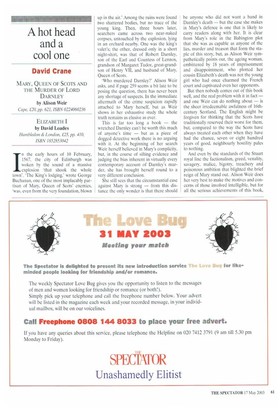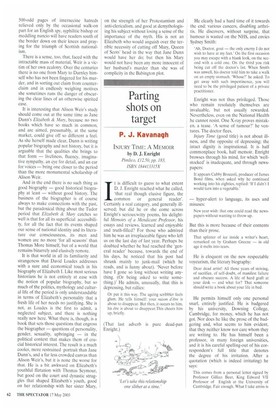A hot head and a cool one
David Crane
MARY, QUEEN OF SCOTS AND THE MURDER OF LORD DARNLEY by Alison Weir Cape, £20, pp. 621, ISBN 0224060236 ELIZABETH I by David Loades Hambledon & London, £25, pp. 410, ISBN 1852853042 Inthe early hours of 10 February, 1567, the city of Edinburgh was woken by the sound of a massive explosion 'that shook the whole town'. 'The King's lodging,' wrote George Buchanan, one of the most implacably partisan of Mary, Queen of Scots' enemies, 'was. even from the very foundation, blown
up in the air.' Among the ruins were found two shattered bodies, but no trace of the young king. Then, three hours later, searchers came across two near-naked corpses, untouched by the explosion, lying in an orchard nearby. One was the king's valet's; the other, dressed only in a short night-shirt, was that of Robert Darnley, son of the Earl and Countess of Lennox, grandson of Margaret Tudor, great-grandson of Henry VII, and husband of Mary. Queen of Scots.
Who murdered Darnley?' Alison Weir asks, and if page 259 seems a bit late to be posing the question, there has never been any shortage of suspects. In the immediate aftermath of the crime suspicion rapidly attached to Mary herself, but as Weir shows in her exhaustive study the whole truth remains as elusive as ever.
This is far too long a book — the wretched Darnley can't be worth this much of anyone's time — but as a piece of dogged detective work there is no arguing with it. At the beginning of her search Weir herself believed in Mary's complicity, but, in the course of sifting evidence and judging the bias inherent in virtually every contemporary account of Darnley's murder, she has brought herself round to a very different conclusion.
She still sees that the circumstantial case against Mary is strong — from this distance the only wonder is that there should be anyone who did not want a hand in Darnley's death — but the case she makes in Mary's defence is one that is likely to carry readers along with her. It is clear from Mary's role in the Babington plot that she was as capable as anyone of the lies, murder and treason that form the staple of this story, but, as Alison Weir sympathetically points out, the ageing woman, embittered by 18 years of imprisonment and disappointment, who plotted her cousin Elizabeth's death was not the young girl who had once charmed the French court and captivated even her opponents.
But then nobody comes out of this book well, and the real problem with it in fact — and one Weir can do nothing about — is the sheer irredeemable awfulness of 16thcentury Scotland. The English might be forgiven for thinking that the Scots have traditionally reserved their worst for them, but, compared to the way the Scots have always treated each other when they have had the chance, seven or eight hundred years of good, neighbourly hostility pales to nothing.
And even by the standards of the Stuart royal line the factionalism, greed, venality, savagery, malice, bigotry, treachery and poisonous ambition that blighted the brief reign of Mary stand out. Alison Weir does her very best to make the motives and concerns of those involved intelligible, but for all the serious achievements of this book, 500-odd pages of internecine hatreds relieved only by the occasional walk-on part for an English spy, syphilitic bishop or meddling nuncio will have readers south of the border down on their knees and praying for the triumph of Scottish nationalism.
There is a sense, too, that, faced with the intractable mass of material, Weir is a victim of her own zealotry. Over the centuries there is no one from Mary to Darnley himself who has not been fingered for his murder, and in sorting out claim from counterclaim and in endlessly weighing motives she sometimes runs the danger of obscuring the clear lines of an otherwise spirited case.
It is interesting that Alison Weir's study should come out at the same time as Jane Dunn's Elizabeth & Mary, because no two books which have so much in common, and are aimed, presumably, at the same market, could give off so different a feel. As she herself made clear, Dunn is writing popular biography and not history, but it is arguable that the qualities she brings to that form — liveliness, fluency, imaginative sympathy, an eye for detail, and an ear for voices — bring one closer to the period than the more monumental scholarship of Alison Weir.
And in the end there is no such thing as good biography — good historical biography at least — without good history. The business of the biographer is of course always to make connections with the past, but the paradoxical thing about the Tudor period that Elizabeth & Mary catches so well is that for all its superficial accessibility, for all the fact that its events shaped our sense of national identity and its literature our consciousness, its men and women are no more 'for all seasons' than Thomas More himself, but of a world that remains bizarrely and elusively remote.
It is that world in all its familiarity and strangeness that David Loades addresses with a sure and economical touch in his biography of Elizabeth I. Like most serious historians he is not entirely at ease with the notion of popular biography, but so much of the politics, mythology and cultural life of the period is only understandable in terms of Elizabeth's personality that a fresh life of her needs no justifying. She is not, as Loades is the first to admit, a neglected subject, and there is nothing really new here. What there is, though, is a book that sets those questions that engross the biographer — questions of personality, gender, sexuality, upbringing — in the political context that makes them of crucial historical interest. The result is a much cooler, more restrained portrait than Jane Dunn's, and a far less crowded canvas than Alison Weir's, but it is none the worse for that. He is a bit awkward on Elizabeth's youthful flirtation with Thomas Seymour, but good on the court and dynastic struggles that shaped Elizabeth's youth, good on her relationship with her sister Mary, on the strength of her Protestantism and anti-clericalism, and good at demythologising his subject without losing a sense of the importance of the myth. His is not an Elizabeth who would anguish over the terrible necessity of cutting off Mary, Queen of Scots' head in the way that Jane Dunn would have her do; but then his Mary would not have been any more innocent of her husband's murder than she was of complicity in the Babington plot.



































































































 Previous page
Previous page